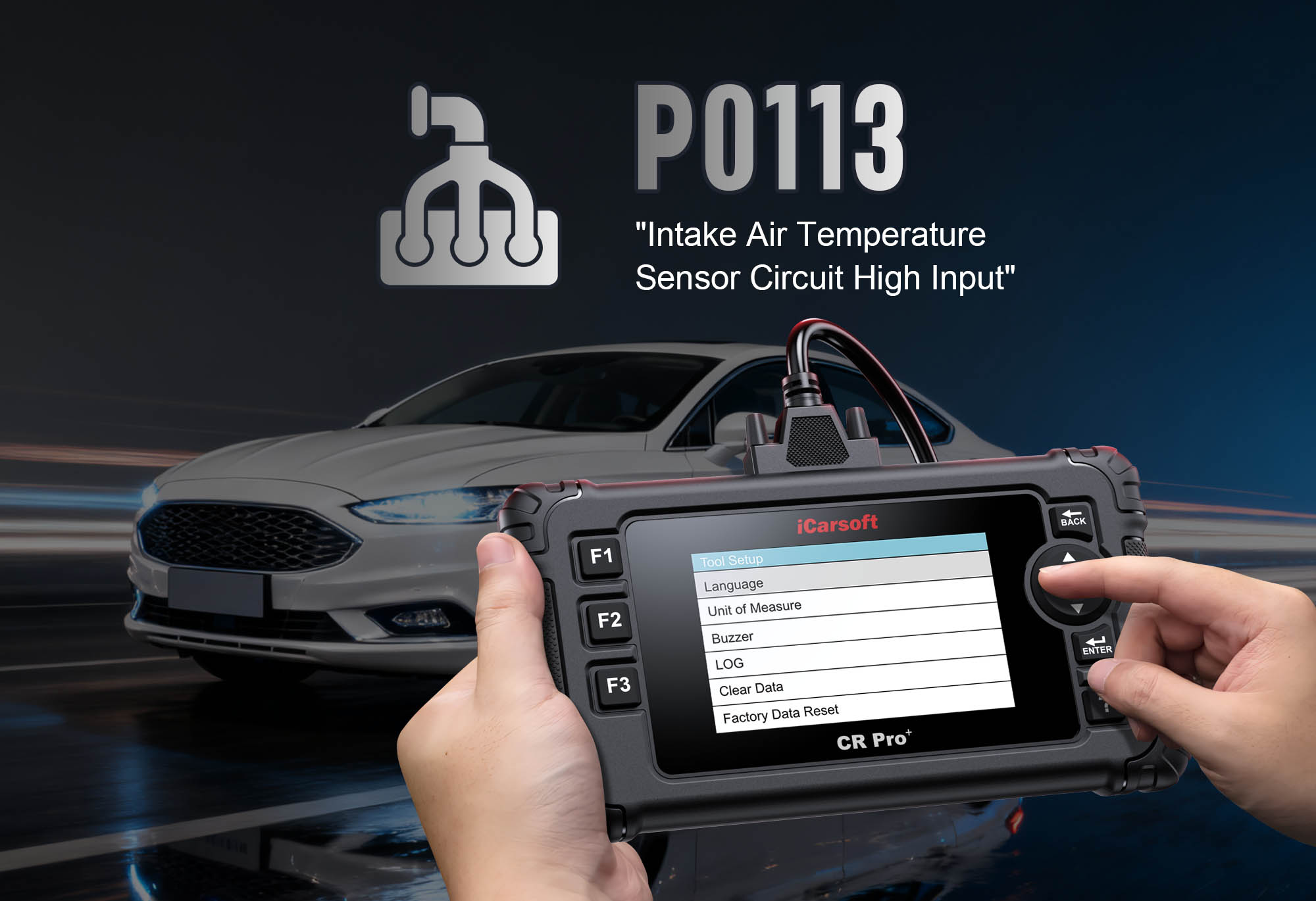Diagnose & Clear P0113 with iCarsoft CR Pro+: Fix Intake Air Temperature Sensor Circuit High Input
If your check engine light illuminates and a scan returns P0113, your vehicle’s engine management system is signaling a critical issue with air temperature monitoring. This generic OBD-II code stands for "Intake Air Temperature (IAT) Sensor Circuit High Input"—indicating the Engine Control Module (ECM) is receiving an abnormally high voltage signal from the IAT sensor, preventing accurate calculation of incoming air density.
The IAT sensor, typically mounted in the air intake manifold or mass airflow (MAF) sensor, measures the temperature of air entering the engine. It sends a variable voltage signal to the ECM: low voltage (e.g., 0.5V) for hot air, and high voltage (e.g., 4.5V) for cold air. This data is critical for adjusting fuel injection—colder, denser air requires more fuel, while warmer air needs less. When P0113 occurs, the sensor sends a voltage exceeding the normal range (often above 5V), causing the ECM to miscalculate fuel delivery, leading to poor performance, increased emissions, and reduced fuel efficiency.
Basic scanners might only confirm "IAT sensor fault" but can’t test sensor voltage or isolate circuit issues. The iCarsoft CR Pro+—with its real-time IAT sensor data, circuit continuity testing, and sensor validation tools—solves this. Let’s walk through how to diagnose and resolve P0113.
 iCarsoft CR Pro+ displaying IAT sensor voltage and temperature data for P0113 diagnosis
iCarsoft CR Pro+ displaying IAT sensor voltage and temperature data for P0113 diagnosis
Understanding P0113: Causes & Key Symptoms
To tackle P0113 effectively, recognize how high sensor input disrupts air-fuel calibration and engine performance:
Key Symptoms of P0113
-
Check Engine Light: Illuminates when the ECM detects sensor voltage above the normal range (e.g., >5V) for 3+ consecutive drive cycles.
-
Poor Cold-Start Performance: The ECM, receiving incorrect "hot air" signals, delivers too little fuel for cold conditions, causing rough starts or stalling.
-
Reduced Power & Acceleration: Mismatched air-fuel ratios (too lean for cold air) lead to sluggish performance, especially at low speeds.
-
Increased Fuel Consumption: Overcompensation for false "hot air" readings can cause the ECM to add excess fuel during warm weather.
-
Erratic Idle: Unstable mixture due to incorrect temperature data creates idle fluctuations (e.g., RPM jumping between 700–900).
-
Emissions Issues: Unbalanced combustion raises hydrocarbon (HC) and nitrogen oxide (NOx) levels, risking failed emissions tests.
Common Causes of P0113
|
Cause
|
Description
|
|
Faulty IAT Sensor
|
Internal electrical failure (e.g., shorted resistor or damaged thermistor) causes the sensor to send a permanently high voltage (accounts for ~40% of P0113 cases).
|
|
Wiring Short Circuit
|
Damaged wire insulation (from heat, vibration, or rodents) creates a direct connection to 12V power (e.g., wire touching the alternator or battery terminal).
|
|
Corroded or Loose Connector
|
Poor contact at the sensor’s plug (white/green corrosion or bent pins) disrupts signal flow, leading to voltage spikes.
|
|
MAF Sensor Malfunction (If Integrated)
|
Many vehicles combine IAT with MAF—damage to the MAF’s circuit board or sensor element affects the integrated IAT signal.
|
|
ECM Error (Rare)
|
A faulty ECM incorrectly interprets normal IAT voltage as "high," usually paired with other electrical codes (e.g., P0606 for ECM internal fault).
|
Why iCarsoft CR Pro+ Excels at Diagnosing P0113
The CR Pro+ outperforms basic tools with features tailored to IAT sensor and circuit diagnostics—critical for pinpointing P0113’s root cause:
Real-Time IAT Sensor Voltage Monitoring
Displays the sensor’s exact voltage (in 0.01V increments) to confirm if it exceeds the normal range (e.g., >5V = P0113 trigger)—no guesswork.
Circuit Continuity & Short Testing
Identifies short circuits, breaks, or excessive resistance in the sensor wiring, eliminating uncertainty about electrical issues.
Sensor Temperature Validation
Compares the IAT sensor’s reading to the scanner’s internal ambient temperature sensor—spots discrepancies (e.g., sensor reads -40°F in 80°F weather = fault).
Vehicle-Specific IAT Sensor Diagrams
Preloaded with color-coded schematics showing sensor locations (intake manifold, MAF, air filter housing) and wiring paths for 65+ makes (e.g., Volkswagen Golf, Jeep Wrangler, Mazda 3).
MAF Integration Tests
If IAT is part of the MAF, the scanner checks both components to avoid misdiagnosing a MAF issue as an IAT fault (saves time and part costs).
Post-Repair Verification
Runs voltage and temperature consistency tests (cold start to warm idle) to ensure the sensor works within manufacturer specs—confirms repairs are successful.
Step-by-Step: Diagnose P0113 with iCarsoft CR Pro+
-
1. Connect & Confirm the Code
Plug the CR Pro+ into your vehicle’s OBD-II port (under the dashboard) and power it on.
Select your vehicle via Auto VIN Scan (reads your VIN in 2 seconds) or manual entry (make/model/year/engine).
Navigate to Engine > Fault Codes > Read Codes to confirm P0113. Tap Code Details for vehicle-specific info (e.g., "Volkswagen: IAT Sensor Voltage = 5.3V – Exceeds Max Threshold").
-
2. Monitor Real-Time IAT Sensor Data
First, verify the high voltage signal with the CR Pro+:
Ensure the engine is off, then turn the ignition to "ON" (don’t start the engine—prevents intake air heating).
Navigate to Engine > Live Data > Air Intake System and select "IAT Sensor Voltage" and "IAT Sensor Temperature (°F/°C)".
Compare readings to manufacturer specs (found in CR Pro+’s "Vehicle Data" section):
- Normal Voltage: 0.5V (212°F/100°C) to 4.5V (-40°F/-40°C).
- P0113 Confirmation: Voltage >5V or temperature stuck at an extreme (e.g., -40°F in 70°F weather) = high input issue.
Note: If voltage is normal but the code persists, the issue may be intermittent (test during cold starts later).
-
3. Locate the IAT Sensor
Find the sensor using the CR Pro+ to avoid guesswork:
Navigate to Component Location > Engine > Air Intake System > IAT Sensor.
The scanner displays a diagram—sensor mounting locations vary by vehicle:
- Integrated with MAF: Part of the MAF sensor (4–6 pin connector in the air intake hose, common in Ford/GM vehicles).
- Intake Manifold: Small 2-pin sensor near the throttle body (e.g., Jeep Wrangler, Toyota Corolla).
- Air Filter Housing: Mounted on the housing (older vehicles like Honda Civic 2000–2005).
Mark the sensor’s location to streamline testing.
-
4. Test the IAT Sensor’s Electrical Function
A faulty sensor is a top cause of P0113—test it with the CR Pro+:
Resistance Test:
Turn off the ignition and disconnect the sensor’s electrical connector.
Navigate to Special Functions > Sensors > IAT Sensor Test.
Connect the scanner’s test leads to the sensor’s terminals (follow on-screen pinout—usually labeled "SIG" and "GND").
Measure resistance at current ambient temperature (use a thermometer for accuracy):
- 70°F/21°C: 2,000–3,000 ohms (varies by make—check CR Pro+ specs).
- 120°F/49°C: 1,000–1,500 ohms.
- 32°F/0°C: 5,000–7,000 ohms.
A reading of 0 ohms (short) or infinite ohms (open) = replace the sensor.
Voltage Supply Check:
Keep the connector disconnected. Turn the ignition to "ON".
Use the CR Pro+’s voltage probe on the connector’s power pin (labeled "5V" in the diagram)—should read 4.8–5.2V (ECM supply voltage). No voltage = wiring break or ECM issue (consult a professional).
-
5. Inspect Wiring & Connector for Short Circuits
A short circuit forces high voltage into the IAT circuit—diagnose with the CR Pro+:
Connector Inspection:
Check the sensor’s connector for corrosion (white/green powdery deposits), bent pins, or water intrusion.
Clean corroded terminals with electrical contact cleaner and a small brush. Straighten bent pins carefully with a needle-nose plier.
Short to 12V Test:
Navigate to Special Functions > Electrical Tests > Short Circuit Test.
Connect one test lead to the sensor’s signal wire (at the connector, labeled "SIG") and the other to the vehicle’s chassis (ground).
A reading <1 ohm = wire is shorted to 12V (look for damaged insulation where the wire touches 12V components like the alternator, battery, or starter).
Wiring Continuity Test:
Test continuity between the sensor connector and the ECM (use the CR Pro+’s wiring diagram to identify the correct ECM pin).
Resistance >1 ohm = wiring damage (repair with heat-shrink butt connectors—use fuel-resistant insulation for under-hood wires).
-
6. Check for MAF Sensor Integration Issues
If the IAT is part of the MAF sensor, test the MAF to rule out combined faults:
Navigate to Special Functions > Sensors > MAF Sensor Test.
Follow on-screen prompts: Start the engine, idle for 2 minutes, then rev to 3,000 RPM.
The scanner evaluates MAF performance (airflow in g/s):
- Normal: 3–7 g/s at idle, 15–25 g/s at 3,000 RPM.
- Faulty: Erratic readings or no change with RPM = MAF issue (replace the entire MAF unit, as IAT is integrated).
Note: Clean the MAF sensor with specialized cleaner first (if readings are marginal)—let dry 10 minutes before retesting.
-
7. Repair & Clear P0113
Fix the root cause based on diagnostics—prioritize low-cost fixes first:
- Faulty IAT Sensor: Replace with an OEM sensor (use CR Pro+’s Part Lookup for compatibility—e.g., Denso 23220-0V010 for Toyota).
- Shorted Wiring: Repair damaged wires with heat-shrink connectors; replace severely corroded harnesses.
- Corroded Connector: Clean or replace the connector (apply dielectric grease to terminals to prevent future corrosion).
- Integrated MAF Fault: Replace the MAF sensor (ensure it’s OEM-spec to match IAT calibration).
Clear the Code: Navigate to Engine > Fault Codes > Clear Codes to delete P0113 and any related air intake faults.
-
8. Validate the Repair
Confirm the sensor and circuit work correctly to avoid P0113 recurrence:
Cold Test (Key On, Engine Off): Turn the ignition to "ON" (engine cold—wait 10+ hours if needed). IAT voltage should match ambient temperature (e.g., 3.5V at 70°F, 4.2V at 32°F).
Warm Test (Engine Running): Start the engine and idle for 5 minutes. Voltage should drop by 0.2–0.5V as intake air warms.
Test Drive: Take a 15-minute drive, including a cold restart (if possible). Check for smooth acceleration, stable idle, and no warning lights.
Re-Scan: Plug the CR Pro+ back in and run a fault code scan—no P0113 recurrence + consistent IAT data = successful repair.
Preventing P0113 Recurrence
The CR Pro+ helps maintain reliable IAT monitoring long-term:
-
Sensor Protection: Avoid spraying high-pressure water directly on the IAT sensor during engine cleaning (use the CR Pro+’s diagram to identify its location).
-
Connector Maintenance: Inspect the sensor connector every 15,000 miles—clean terminals with contact cleaner and apply dielectric grease to repel moisture.
-
Wiring Checks: Routinely inspect intake system wiring for damage from rodents (common in garaged vehicles), heat (near exhaust components), or vibration (off-road use).
-
MAF Care (If Integrated): Clean the MAF sensor every 30,000 miles with specialized MAF cleaner—never use compressed air (can damage the sensor).
-
Extreme Temperature Prep: In cold climates, clear ice/snow from the air intake and sensor before starting—frozen sensors send incorrect high-voltage signals.
-
Air Filter Replacement: Change the air filter every 10,000–15,000 miles—clogged filters cause turbulent airflow, which can disrupt IAT readings.
Conclusion
P0113’s high IAT sensor input may seem like a minor electrical fault, but it disrupts the critical air-fuel balance needed for efficient combustion. The iCarsoft CR Pro+ turns this vague issue into a solvable problem—with its voltage monitoring, circuit tests, and vehicle-specific guides, it clearly identifies whether the fault lies in the sensor, wiring, or integrated MAF.
Whether you’re replacing a standalone IAT sensor, repairing a shorted wire, or swapping an integrated MAF unit, the CR Pro+ provides the precision needed to fix the root cause. With this guide, you’ll turn an "IAT sensor high input" fault into a confident repair—keeping your engine’s air-fuel mixture optimized for performance, fuel efficiency, and emissions compliance, no matter the weather or driving conditions.
FAQs About P0113 Code
Q: Can I drive my vehicle with P0113?
A: Yes, but with limitations. P0113 doesn’t cause immediate engine damage, but it leads to poor cold starts, reduced power, and increased fuel consumption. Avoid long drives or cold-weather trips until fixed—prolonged driving with incorrect air-fuel ratios can damage the catalytic converter over time.
Q: How much does it cost to fix P0113?
A: Costs are low for most fixes: Standalone IAT sensor = $20–$80 (DIY); wiring repair = $10–$40 (DIY); MAF sensor (integrated IAT) = $80–$250 (DIY); professional labor = $80–$150 (if you can’t locate the sensor). The CR Pro+ saves money by avoiding unnecessary MAF replacement if only the IAT is faulty.
Q: Why does P0113 come back after replacing the sensor?
A: Common reasons: 1) Unrepaired short circuit in wiring (sensor works but voltage is still high); 2) Corroded connector (not cleaned/replaced); 3) Mismatched sensor (aftermarket IAT doesn’t match OEM voltage specs); 4) Integrated MAF fault (if IAT is part of MAF). Re-run the CR Pro+’s circuit tests to find leftover issues.
Q: Do I need to reset the ECM after fixing P0113?
A: No—clearing the code via the CR Pro+ (Step 7) resets the ECM’s fault memory. However, the ECM may take 1–2 drive cycles to fully recalibrate IAT data. For best results, take a 20-minute drive (city + highway) after repair to let the ECM learn normal sensor values.
Q: Can a dirty air filter cause P0113?
A: Indirectly. A clogged air filter causes turbulent airflow in the intake, which can disrupt the IAT sensor’s ability to read consistent temperatures (leading to intermittent voltage spikes). However, a dirty filter alone rarely causes a permanent P0113—if the code persists after filter replacement, the issue is likely a sensor or wiring fault.

 iCarsoft CR Pro+ displaying IAT sensor voltage and temperature data for P0113 diagnosis
iCarsoft CR Pro+ displaying IAT sensor voltage and temperature data for P0113 diagnosis



